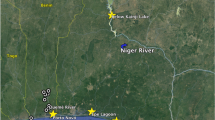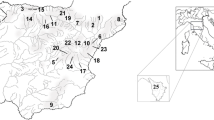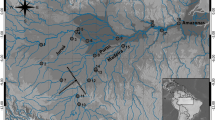Abstract
Reliable biological identification is essential for effective management programs for fishery resources. In many cases, individuals of species with overlapping features and/or subtle morphological differences can be misidentified by traditional taxonomic procedures. The conservation status (i.e., genetic diversity) of commercial fishery stocks of the Southern Atlantic are in general poorly understood. The halfbeak populations found off the coast of northeastern Brazil represent a suitable model for testing controversial identifications, given that the two local species (Hemiramphus brasiliensis and H. balao) not only present very subtle morphological differences, but are also harvested intensively. The present study examined the potential occurrence of the two species off the coast of the Brazilian state of Pernambuco using a multilocus DNA approach, which also provided insights into the conservation status of these stocks in relation to the genetic variation found in both mitochondrial and nuclear regions, analyzed by molecular systematics and population genetics parameters. The results indicated the presence of only one halfbeak species in the region, reinforced by phylogenetic relationships and population genetics in both mitochondrial and nuclear loci. The conservation status of the stocks in terms of their genetic diversity appears to be good despite the intense exploitation. The results of this study provide a new perspective for the conservation and management of this fishery resource, particularly given the fact that the intensive exploitation over the last five decades appears to have impacted a single species, rather than two.








Similar content being viewed by others
References
Almany GR, Hamilton RJ, Bode M, Matawai M, Potuku T, Saenz-Agudelo P, Planes S, Berumen ML, Rhodes KL, Thorrold SR, Russ GR, Jones GP (2013) Dispersal of grouper larvae drives local resource sharing in a coral reef fishery. Curr Biol 23(7):626–630
Avise JC (2000) Phylogeography: The History and Formation of Species. Harvard University Press
Avise JC (2004) Molecular markers, natural history and evolution. Sinauer Associates, Sunderland
Barry PD, Tamone SL, Tallmon DA (2013) A complex pattern of population structure in the North Pacific giant octopus Enteroctopus dofleini (Wülker, 1910). J Mollus Stud 79(2):133–138
Berkeley SA (1975) Fishery and biology of balyhoo on the southeast Florida coast. University of Miami, Sea Grant Program, p 15
Boguski DA, Reid SB, Goodman DH, Docker MF (2012) Genetic diversity, endemism and phylogeny of lampreys within the genus Lampetra sensu stricto (Petromyzontiformes: Petromyzontidae) in western North America. J Fish Biol 81:1891–1914
Bowen BW, Meylan AB, Ross JP, Limpus CJ, Balazs GH, Avise JC (1992) Global population structure and natural history of the green turtle (Chelonia mydas) in terms of matriarchal phylogeny. Evolution 46(4):865–881
Bridge PD, Roberts PJ, Spooner BM, Panchal G (2003) On the unreliability of published DNA sequences. New Phytol 160:43–48
Byrne RJ, Bernardi G, Avise JC (2013) Spatiotemporal genetic structure in a protected marine fish, the california grunion (Leuresthes tenuis), and Relatedness in the genus Leuresthes. J Hered 104(4):521–531
Caballero S, Santos MCO, Sanches A, Mignucci-Giannoni AA (2013) Initial description of the phylogeography, population structure and genetic diversity of Atlantic spotted dolphins from Brazil and the Caribbean, inferred from analyses of mitochondrial and nuclear DNA. Biochem Syst Ecol 48:263–270
Calendini F, Martin JF (2005). PaupUP v1.0.3.1 A free graphical frontend for Paup* Dos software
Caragiulo A, Dias-Freedman I, Clark JA, Rabinowitz S, Amato G (2014) Mitochondrial DNA sequence variation and phylogeography of Neotropic pumas (Puma concolor). Mitoch DNA 25(4):304–312
Carvalho DC, Oliveira D, Pompeu PS, Leal CG, Oliveira C, Hanner R (2011) Deep barcode divergence in Brazilian freshwater fishes: the case of the São Francisco River basin. Mitoch DNA 22(S1):80–86
Carvalho DC, Oliveira DAA, Beheregaray L, Torres RA (2013a) Hidden genetic diversity and distinct evolutionarily significant units in an commercially important Neotropical apex predator, the catfish Pseudoplatystoma corruscans. Conserv Genet 13(6):1671–1675
Carvalho DC, Seerig AS, Brasil BSAF, Crepaldi DV, Oliveira DAA (2013b) Molecular identification of the hybrid between the catfish species Pseudoplatystoma corruscans and Pseudoplatystoma reticulatum using a set of eight microsatellite markers. J Fish Biol 83(3):671–676
Casu M, Lai T, Curini-Galletti M, Ruiu A, Pais A (2009) Indentification of mediterranean Diplodus spp. and Dentex dentex (Sparidae) by means of DNA Inter-Simpre Sequence Repeat (ISSR) markers. J Exp Mar Biol Ecol 368(2):147–152
Collette BB (2003) Hemiramphidae. In: KE Carpenter (ed) FAO species identification guide for fishery purposes. The living marine resources of the Western Central Atlantic. Vol 2: Bony fishes part 1 (Acipenseridae to Grammatidae). Ref No [50879] Key No [966] pp 1135–1144
Craig MT, Graham RT, Torres RA, Hyde JR, Freitas MO, Ferreira BP, Hostim-Silva M, Gerhardinger LC, Bertoncini AA, Robertson DR (2009) How many species of goliath grouper are there? Cryptic genetic divergence in a threatened marine fish and the resurrection of a geopolitical species. Endang Spec Res 7:167–174
Daly-Engel TS, Randall JE, Bowen BW (2012) Is the great barracuda (Sphyraena barracuda) a reef fish or a pelagic fish? The phylogeographic perpective. Mar Biol 159(5):975–985
Darriba D, Taboada GL, Doallo R, Posada D (2012) jModelTest 2: more models, new heuristics and parallel computing. Nat Methods 9(8):772
DiBattista JD, Berumen ML, Gaither MR, Rocha LA, Eble JA, Choat JH, Craih MT, Skilings DJ, Bowen BW (2013) After continents divide: comparative phylogeography of reef fishes from the Red Sea and Indian Ocean. J Biogeogr 40(6):1170–1181
DiBattista JD, Waldrop E, Bowen BW, Schultz JK, Gaither MR, Pyle RL, Rocha LA (2012) Twisted sister species of pygmy angelfishes: discordance between taxonomy, coloration, and phylogenetics. Coral Reefs 31:839–851
Evanno G, Regnaut S, Goudet J (2005) Detecting the number of clusters of individuals using the software structure : a simulation study. Mol Ecol 14:2611–2620
Excoffier L, Lischer HEL (2010) Arlequin suite ver 3.5: a new series of programs to perform population genetics analyses under Linux and Windows. Mol Ecol Res 10:564–567
Excoffier L, Smouse PE, Quattro JM (1992) Analysis of molecular variance inferred from metric distance among DNA haplotypes: application to human mitochondrial DNA data. Genetics 131:479–491
Excoffier L, Laval G, Schneider S (2005) Arlequin (version 3.0): an integrated software package for population genetics data analysis. Evol Bioinform Online 1:47–50
Falush D, Stephens M, Pritchard JK (2003) Inference of population structure using multilocus genotype data: linked loci and correlated allele frequencies. Genetics 164(4):1567–1587
Falush D, Stephens M, Pritchard JK (2007) Inference of population structure using multilocus genotype data: dominant markers and null alleles. Mol Ecol Not 4(7):574–578
Farias I, Ortí G, Sampaio I, Schneider H, Meyer A (2001) The cytochrome b gene as a phylogenetic marker: the limits of resolution for analyzing relationships among cichlid fishes. J Mol Evol 53:89–103
Floeter SR, Rocha LA, Robertson DR, Joyeux JC, Smith-Vaniz WF, Wirtz P, Edwards AJ, Barreiros JP, Ferreira CEL, Gasparini JL, Brito A, Falcón JM, Bowen BW, Bernardi G (2008) Atlantic reef fish biogeography and evolution. J Biogeogr 35:22–47
Fraga E, Schneider H, Nirchio M, Santa-Brigida E, Rodrigues-Filho LF, Sampaio I (2007) Molecular phylogenetic analyses of mullets (Mugilidae, Mugiliformes) based on two mitochondrial genes. J Appl Ichthyol 23:598–604
Frankham R, Ballou J, Briscoe D, Mcinnes K (2004) A primer of conservation genetics. Cambridge University Press, Cambridge
Hall TA (1999) BioEdit: a user-friendly biological sequence alignment editor and analysis program for Windows 95/98/NT. Nucleic Acids Symp Ser 41:95–98
Hall BG (2001) Phylogenetics trees made easy. A how to manual for molecular biologists. Sinauer Associates. Inc, Sunderland
Hartl DL, Clark AG (2010) Princípios de Genética de Populações, 4th edn. ArtMed, Porto Alegre-RS
Hazkani-Covo E, Zeller RM, Martin W (2010) Molecular poltergeists: mitochondrial DNA copies (numts) in sequenced nuclear genomes. PLoS Genet 6(2):e1000834. doi:10.1371/journal.pgen.1000834
Hedrick PW (1999) Highly variable loci and their interpretation in evolution and conservation. Evolution 53(2):313–318
Hosseinali A, Homayoun HS, Aria AA, Shahrokh S (2011) Cytochrome c oxidase subunit 1 barcode data of fish of the Nayband National Park in the Persian Gulf and analysis using meta-data flag several cryptic species. Mol Ecol Res 11(3):461–472
Hubisz MJ, Falush D, Stephens M, Pritchard JK (2009) Inferring weak population structure with the assistance of sample group information. Mol Ecol Res 9:1322–1332
Huelsenbeck JP, Ronquist F (2001) MrBayes: Bayesian inference of phylogenetic trees. Bioinformatics 17(8):754–755
Ibama (2005) Boletim Estatístico da Pesca marítima e Estuarina do Nordeste do Brasil—2004. Centro de Pesquisas e Gestão dos Recursos Pesqueiros do Litoral Nordeste. Tamandaré—PE
Ivanova NI, Zemlak TS, Hanner RH, Hebert PDN (2007) Universal primer cocktails for fish DNA barcoding. Mol Ecol Not 7(4):544–548
Keith R, Hedin M (2012) Extreme mitochondrial population subdivision in southern Appalachian paleoendemic spiders (Araneae: Hypochilidae: Hypochilus), with implications for species delimitation. J Arachnol 40(2):167–181
Keskin E, Atar HH (2012) Genetic structuring of European anchovy (Engraulis encrasicolus) populations through mitochondrial DNA sequences. Mitochon DNA 23(2):62–69
Keskin E, Ağdamar S, Tarkan AS (2013) DNA barcoding common non-native freshwater fish species in Turkey: low genetic diversity but high population structuring. Mitochon DNA 24(3):276–287
Kullander SO, Norén M, Friðriksson GB, Santos de Lucena CA (2010) Phylogenetic relationships of species of Crenicichla (Teleostei: Cichlidae) from southern South America based on the mitochondrial cytochrome b gene. J Zool Syst Evol Res 48:248–258
Kumla S, Doolgindachbaporn S, Sudmoon R, Sattayasai N (2012) Genetic variation, population structure and identification of yellow catfish, Mystus nemurus (CandV) in Thailand using RAPD, ISSR and SCAR marker. Mol Biol Rep 39:5201–5210
Lessa R, Vieira ACS, Monteiro A, Santos JS, Lima MM, Cunha EJ, Souza-Jr JCA, Bezerra S, Travassos PEPF, Oliveira BABR (2006) Diagnóstico da pesca no litoral do estado de Pernambuco. In: Isaac VJ, Martins AS, Haimovici M, Andriguetto-Filho JM (eds) A pesca marinha e estuarina do Brasil no início do século XXI: recursos, tecnologias, aspectos socioeconômicos e institucionais. Editora Universitária UFPA, Bélem, pp 67–91
Librado P, Rozas J (2009) DnaSP v5: a software for comprehensive analysis of DNA polymorphism data. Bioinformatics 25:1451–1452
Liu Y-G, Yu Z-G, Bao B-L, Sun X-Q, Shi Q-L, Liu L-X (2009) Population genetics studies of half-smooth tongue sole Cynoglossus semilaevis using ISSR markers. Biochem Syst Ecol 36:821–827
Li W, Sun W-X, Fan J, Zhang C-C (2013) Genetic diversity of wild and cultured swamp eel (Monopterus albus) populations from central China revealed by ISSR markers. Biol 68(4):727–732
Lleonart J, Taconet M, Lamboeuf M (2006) Integrating information on marine species identification for fishery purposes. Mar Ecol Prog Ser 316:231–238
Lovejoy NR (2000) Reinterpreting recapitulation: systematics of needlefishes and their allies (Teleostei: Beloniformes). Evolution 54:1349–1362
Mariguela TC, Paiva LRS, Foresti F, Oliveira C (2011) 5S rDNA chromosomal mapping and COI sequence analysis reveal differentiation among distinct populations of a characid fish Serrapinnus notomelas. Rev Fish Biol Fish 21(4):779–788
Mcbride RS, Thurman PE (2003) Reproductive biology of Hemiramphus brasiliensis and H. balao (Hemiramphidae): maturation, spawning, frequency, and fecundity. Biol Bull 204:57–67
Mendonça FF, Oliveira C, Gadig OBF, Foresti F (2013) Diversity and genetic population structure of the Brazilian sharpnose shark Rhizoprionodon lalandii. Aquat Conserv: Mar Freshw Ecosyst 23(6):850–857
Meyer A (1994) Shortcomings of the cytochrome b gene as a molecular marker. Trends Ecol Evol 9(8):278–280
Mills LS, Allendorf FW (1996) The one-migrant-per-generation rule in conservation and management. Conserv Biol 10(6):1509–1518
Mitcheson YS, Craig MT, Bertoncini AA, Carpenter KE, Cheung WWL, Choat JH, Cornish AS, Fennessy ST, Ferreira BP, Heemstra PC, Liu M, Myers RF, Pollard DA, Rhodes KL, Rocha LA, Russell BC, Samoilys MA, Sanciangco J (2013) Fishing groupers towards extinction: a global assessment of threats and extinction risks in a billion dollar fishery. Fish Fisher 14(2):119–136
Moysés CB, Daniel-Silva MFZ, Lopes CE, Almeida-Toledo LF (2010) Cytotype-specific ISSR profiles and karyotypes in the Neotropical genus Eigenmannia (Teleostei: Gymnotiformes). Genetica 138:179–189
Nirchio M, Cequea H (1998) Karyology of Mugil liza and M. curema from Venezuela. Bol Investig Mar Cost 27:45–50
Nirchio M, Cipriano R, Cestari M, Fenocchio AS (2005) Cytogenetical and morphological features reveal significant differences among Venezuelan and Brazilian samples of Mugil curema (Teleostei: Mugilidae). Neotrop Ichthyol 3(1):107–110
Packer L, Gibbs J, Sheffield C, Hanner R (2009) DNA barcoding and the mediocrity of morphology. Mol Ecol Res 9(Suppl 1):42–50
Padial JM, Miralles A, De la Riva I, Vences M (2010) The integrative future of taxonomy. Front Zool 7:16
Pazza R, Kavalco KF, Prioli SMAP, Prioli AJ, Bertollo AC (2007) Chromosome polymorphism in Astyanax fasciatus(Teleostei, Characidae), Part 3: analysis of the RAPD and ISSR molecular markers. Biochem Syst Ecol 35:843–851
Pinsky ML, Palumbi SR (2014) Meta-analysis reveals lower genetic diversity in overfished populations. Mol Ecol 23:29–39
Portnoy DS, Hollenbeck CM, Renshaw MA, Cummings NJ, Gold JR (2013) Does mating behaviour affect connectivity in marine fishes? Comparative population genetics of two protogynous groupers (Family Serranidae). Mol Ecol 22:301–313
Pritchard JK, Stephens M, Donnelly P (2000) Inference of population structure using multilocus genotype data. Genetics 155:945–959
Prodocimo V, Tscha MK, Pie MR, Oliveira-Neto JF, Ostrensky A, Boeger WA (2008) Lack of genetic differentiation in the fat snook Centropomus parallelus (Teleostei: Centropomidae) along the Brazilian coast. J Fish Biol 73:2075–2082
Ribeiro AO, Caires RA, Mariguela TC, Pereira LHG, Hanner R, Oliveira C (2012) DNA barcodes identify marine fishes of São Paulo State, Brazil. Mol Ecol Res 12:1012–1020
Roberts MA, Schwartz TS, Karl SA (2004) Global population genetic structure and male-mediated gene glow in the green sea turtle (Chelonia mydas): analysis of microsatellite loci. Genetics 166:1857–1870
Rocha LA, Bass AL, Robertson DR, Bowen BW (2002) Adult habitat preferences; larval dispersal; and the comparative phylogeography of three Atlantic surgeonfishes (Teleostei: Acanthuridae). Mol Ecol 11:243–252
Ronquist F, Huelsenbeck JP (2003) MrBayes 3: Bayesian phylogenetic inference under mixed models. Bioinformatics 19(12):1572–1574
Saitou N, Nei M (1987) The Neighbor-joining method: a new method for reconstructing phylogenetic trees. Mol Biol Evol 4(4):406–425
Sambrook J, Russell DW (2001) Molecular cloning. A Laboratory Manual. I, II, III, 3rd edn. Cold Spring Harbor Laboratory Press, New York
Santos SM (1967) Contribuição ao estudo da agulha-preta (Hemiramphus brasiliensis) (Pisces, Beloniformes, Hamiramphidae). Trab Oceanográf 9(11):285–304
Santos S, Schneider H, Sampaio I (2003) Genetic differentiation of Macrodon ancylodon (Sciaenidae, Perciformes) populations in Atlantic coastal waters of South America as revealed by mtDNA analysis. Genet Mol Biol 26(2):151–161
Santos S, Hrbek T, Farias IP, Schneider H, Sampaio I (2006) Population genetic structuring of the king weakfish, Macrodon ancylodon (Sciaenidae), in Atlantic coastal waters of South America: deep genetic divergence without morphological change. Mol Ecol 15:4361–4373
Seyoum S, Tringali MD, Barthel BL, Puchulutegui C, Davis MC, Collins AB, Craig MT (2013) Isolation and characterization of 29 polymorphic microsatellite markers for the endangered Atlantic goliath grouper (Epinephelus itajara), and the Pacific goliath grouper (E. quinquefasciatus). Conserv Genet Res 5:729–732
Silva-Oliveira GC, Silva ABC, Oliveira Y, Nunes ZP, Torres RA, Sampaio I, Vallinoto M (2013) New nuclear primers for molecular studies of Epinephelidae fishes. Conserv Genet Res 5(1):165–168
Sinclair W, Newman SJ, Vianna GMS, Williams S, Aspden WJ (2011) Spatial subdivision and genetic diversity in populations on the east and west coasts of Australia: the multi-faceted case of Nautilus pompilius (Mollusca, Cephalopoda). Rev Fisher Sci 19(1):52–61
Smith MF, Patton JL (1993) The diversification of South American murid rodents: evidence from mitochondrial DNA sequence data for the Akodontine tribe. Biol J Linn Soc 50:149–177
Sodré D, Rodrigues-Filho LFS, Souza RFC, Rêgo PS, Schneider H, Sampaio I, Vallinoto M (2012) Inclusion of South American samples reveals new population structuringof the blacktip shark (Carcharhinus limbatus) in the western Atlantic. Genet Mol Biol 35(4):752–760
Song H, Buhay JE, Whiting MF, Crandall KA (2008) Many species in one: DNA barcoding overestimates the number of species when nuclear mitochondrial pseudogenes are coamplified. Proc Natl Acad Sci 115(36):13486–13491
Swofford DL (2002) PAUP*. Phylogenetic analysis using parsimony (*And Other Methods). V.4.0b10. Sunderland, Massachucets. Sinauer
Tatarenkov A, Lima SMQ, Avise JC (2011) Extreme homogeneity and low genetic diversity in Kryptolebias ocellatus from south-eastern Brazil suggest a recent foundation for this androdioecious fish population. J Fish Biol 79:2095–2105
Torres RA, Feitosa RB, Carvalho DC, Freitas MO, Hostim-Silva M, Ferreira BP (2013) DNA barcoding approaches for fishing authentication of exploited grouper species including the endangered and legally protected goliath grouper Epinephelus itajara. Scient Mar 77:409–418
Vianna JA, Bonde RK, Caballero S, Giraldo JP, Lima RP, Clark A, Marmontel M, Morales-Vela B, Souza MJ, Parr L, Rodríguez-Lopez MA, Mignucci-Giannoni AA, Powell JA, Santos FR (2006) Phylogeography, phylogeny and hybridization in trichechid sirenians: implications for manatee conservation. Mol Ecol 15:433–447
Ward RD, Zemlak TS, Innes BH, Last PR, Hebert PDN (2005) DNA barcoding Australia’s fish species. Phil Trans R Soc B 360:1847–1857
Wright S (1978) Evolution and the genetics of populations, vol 4. University of Chicago Press, Chicago, USA
Yeh FCT, Boyle ZYE, Xiyan JM (1999) PopGene. Version 1.31: Microsoft Windows-based freeware for population genetic analysis. University of Alberta and Center for International Forestry Research
Acknowledgments
We are grateful to Dr. Tania Rieger and Dr. Sergio Maia Queiroz Lima for their valuable comments at the original manuscript, as well as CNPq and FACEPE for the Grants that supported this research. The authors are also grateful for the comments from the two anonymous referees. R.A.Torres is grateful to Carole Baldwin, PhD (Smithsonian Institution) and Nathan Lovejoy, PhD (University of Toronto Scarborough) for their valuable information about the vouchered sequences of Hemiramphus spp. from genebank. R.A.Torres is especially grateful to CNPq for the research fellowship provided (Grant Numbers 306099/2011-0 and 301208/2012-3). This study is a contribution of inctAmbTrop—Brazilian National Institute of Sciences and Technology for Tropical Marine Enviroments CNPq/FAPESB Grants: 565054/2010-4 and 8936/2011.
Author information
Authors and Affiliations
Corresponding author
Electronic supplementary material
Below is the link to the electronic supplementary material.
Rights and permissions
About this article
Cite this article
Torres, R.A., dos Santos, F.A., Andrade, F.R.S. et al. Disentangling the controversial identity of the halfbeak stock (Hemiramphus brasiliensis and H. balao) from northeastern Brazil using multilocus DNA markers. Rev Fish Biol Fisheries 25, 379–394 (2015). https://doi.org/10.1007/s11160-015-9381-2
Received:
Accepted:
Published:
Issue Date:
DOI: https://doi.org/10.1007/s11160-015-9381-2




